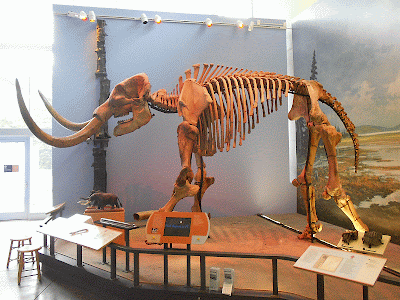"Nobody believed me," he said. "They thought some guy from Hyde Park found a cow bone and thinks it's a dinosaur."
Eventually Lozier got an archaeology professor from Bard College interested in taking a look. The bone was recognized as belonging to a mastodon and things moved quickly from that point. Media coverage followed and in the late summer of 2000, paleontologists from Ithaca's Paleontological Research Institute pumped the pond and began professionally excavating the find.
The excavation was done with the help of a lot of volunteers from local colleges (except where I teach, no one told us about it since we're just a lowly community college). It was muddy work as the pond was spring fed and constant pumping was required.
It was an amazing find with 95% of the bones recovered including the important skull, both tusks, and all the major limb bones. It was an older male (30-40 years old) specimen of an American mastodon (Mammut americanum). He weighed anywhere from 10,000 -15,000 pounds (4,500 - 6,800 kg) when alive and stood about 9 feet tall at his shoulder.
Overview of the site
The 1999-2000 academic year was my first year teaching in the area and, as I said, our college was out of the loop, so I didn't find out about the Hyde Park mastodon it until I read about the excavation in a local newspaper. I drove over to visit the site, met the family and some volunteers who were very friendly, and was fortunate enough to be able to go down into the pit, collect some of the muck (more about that in a bit), and see some bones (the skull was already crated).
Decade old version of me with a femur
The upside-down crated skull
Spruce log in the pit
Another shot of some limb bones
The "muck" containing small freshwater invertebrate shells
The mastodon (and the spruce log above) were radiocarbon dated to 11,500 years old. This is the end of the great Pleistocene Ice Age when the glaciers were retreating up the Hudson Valley and this area was changing from tundra to conifer forest (hence the spruce log). The mastodon was walking through the area, perhaps over a frozen pond where he fell through the ice where he drowned. Buried by sediments, soft tissues rotted away, but his bones were preserved to the present day.
Last week, my family and some friends spent a couple of days at Watkins Glen. We also made a side trip to the wonderful Museum of the Earth in nearby Ithaca (HIGHLY recommended!). Guess what's there? The Hyde Park mastodon in all its reconstructed glory!
Side view
Front view (pretty impressive tusks!)
Skull
It wasn't that long ago (a geologic instant of time) that these guys were tromping around in our backyards here in the Hudson Valley.
The Discovery Channel did a neat show called Mastodon in Your Backyard on the find. Here's an excerpt you can watch online (I have a copy of the VHS video, but don't think it's sold anymore - it may be in local public libraries).
By the way, mammoths and mastodons are two different groups of animals. They both, along with modern African and Asiatic elephants, belong to the mammalian order of Proboscidea. Mastodons (family Mammutidae, genus Mammut) split off from this line around 27 million years ago (Oligocene Epoch) while mammoths (family Elephantidae, genus Mammuthus) split off only around 5 million years ago (Pliocene Epoch) just before the Pleistocene ice age. Mammoths, being in the same taxonomic family, are more closely related to modern elephants.
While most, but not all, species of mammoths were larger than mastodons, and often had longer tusks, the real difference between the these two extinct beasts were in their teeth. The picture below shows someone holding a mastodon tooth on the left and a mammoth tooth on the right.
Image from http://www.lakeneosho.org/Paleolist/46/
The word mastodon literally means "breast tooth" due to the nipple-like bumps on their molars (at least as seen by French anatomist Georges Cuvier in 1806). Their teeth were adapted for browsing - eating shrubs, leaves, grass, whatever. Mammoth teeth, on the other hand, are long and flat with ridges. Their teeth were adapted for grazing on grasses.
A final aside... You may also see the alternative spelling of mastodont with a "t". Technically, it's supposedly more correct with the "t" given it's derivation from Greek roots (an orthodontist, for example, puts braces on your teeth to make them straight) but you'll see both spellings routinely used.




















I remember this. I was working at the same company as Cathy after I left the college.
ReplyDeleteGreat website! I teach Earth Science in Amenia at Webutuck HS. Thank you.
ReplyDeleteI was the excavator hired by PRI in 2000 and along with a good shovel man by the name of Curt found the skull.Thrill of a lifetime.My Scout troop and I have visited the big guy twice now up in Ithaca.Very cool the first time we went and a scout pushed the monitor button and proclaimed ''Mr. Mallen,that's you.''
ReplyDeleteWonderful "save" by all involved.
ReplyDelete